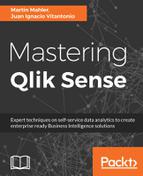As the name of this chapter suggests, best practices can be applied anywhere throughout the life cycle of a project. From coding to test cases, there are lots of best practices one can follow to keep a data project tidy and organized.
In the previous chapter, we learned how powerful the Qlik engine is, and we also described guidelines to optimize your model.
Qlik Sense data is stored in memory so every bit of data we load counts. As well as RAM capacity, we must understand how we can load data in an optimized way. Qlik Sense scripting is extremely powerful, but with great power comes great responsibility. You, as a Qlik Sense enthusiast, must ensure your loading techniques are accurate and follow best practices within the Qlik Sense world.
In order for all of us to work and understand different projects, it is important that the majority of us follow common guidelines. The internet and books like this help knowledge and experience spread. Pick what you like from this book, mix it with other ideas out there, and create your own way of doing things. Nothing fits all. You will have to adapt the methodologies and best practices to your reality. Perhaps documenting your code will do. Or maybe adding more complex controls is necessary in your organization. Whatever it is that you do, do it right. Be clean and precise and make sure that everything in your project is easy to understand to others.
In this chapter we will learn about the following topics:
- Data loading concepts and the different ways of loading data into our application
- Data load optimization
- Loading data incrementally
- The extract, transform, load (ETL) approach
